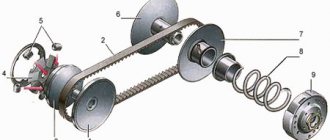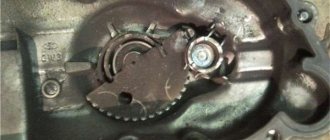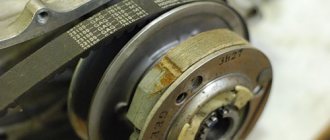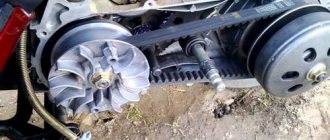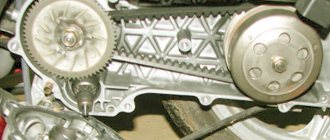Scooter variator device
A variator is a part responsible for a smooth change in speed. It is a unit of two pulleys (driver and driven) connected to a belt. The degree of load on the main variator depends on the intensity of engine rotation. When driving at high speed, the number of rotations is maximum, which is why the variator parts wear out faster.
The belt is attached to the pulley at the sides. If the CVT bushing wears, the belt cuts deeper into the pulley. When the drive pulley operates, the belt smoothly compresses and unclenches. A sports CVT on a scooter makes more revolutions. The belt may need to be replaced sooner.
Even a new scooter can fail over time due to improper use.
How to replace a belt
The scooter's variator can withstand a mileage of up to 6 thousand km. The belt lasts the same amount of time. The part may last longer, but you still need to regularly diagnose it. You can do it yourself if you have special knowledge in this area.
Symptoms of a problem
- When the speed increases, the engine rotates quickly, but the clutch does not work. In this case, the transport does not budge. This means the belt has broken.
- The carburetor is normal, but it is still impossible to reach the maximum speed. The reason is that the variator does not reach its maximum radius due to damage.
- The belt lasts very little if it is a cheap fake. You need to disassemble the device and evaluate the appearance of the belt. If it is stretched, then it's time to change it. Due to deviation from the desired value, the transmission stops working as it should.
Main causes of failure
The main causes of CVT malfunctions are violation of operating rules:
- rare oil changes;
- use of low-quality oils;
- aggressive driving;
- sudden braking;
- long trips at top speed.
Mileage up to 6 thousand km. withstands scooter variator
The reasons for the breakdown may be other. One of them is a faulty bearing in the variator, which manifests itself in the appearance of a hum. Noise is often attributed to worn wheel bearings, making it difficult for a beginner to identify the real cause of the problem. The difficulty is that the bearings can be damaged even with low mileage due to aggressive driving.
Another cause of damage is metal dust. The chain and variator pulleys rub against each other, so they gradually wear down.
Dust gets into the oil and then to the bearings. To find this dust, oil filters are present in the design. But neither they nor regular oil changes prevent the appearance of dust.
Another reason for variator failure is the accumulation of metal dust in the oil pump. It penetrates the valves and disrupts their operation, and also leads to pressure surges in the pump. The pulleys move chaotically, causing the belt to wear off. As a result, the vehicle jerks while driving. If you don't fix the variator, you'll have to replace the gearbox.
The variator may fail due to belt damage. This part is a device consisting of many plates located on a bundle of metal strips. Due to the uneven surface, they are better attached to the pulleys. They gradually wear out, and accumulated dust prevents the device from working properly. Because of this, the variator belt slips, jerking the vehicle. In this case, repairs are required immediately.
Due to belt damage, the variator may fail
The most harmless malfunction is that when driving fast, a sign flashes on the panel, indicating that the transmission is overheating. The vehicle stops abruptly to cool down. This indicates that the oil pump cooling system is clogged and has stopped working normally. For preventive purposes, it is necessary to clean radiators twice a year.
How to choose a new one
Scooter belts vary in size and markings. The characteristics are indicated in the transport passport. You cannot fit a larger belt size. Because of this, the dynamics of the vehicle may be disrupted.
Example. The driver changed the belt, after which the variator began to operate in normal mode. But, when squeezing the maximum speed, the belt tore into pieces. The reason is the incorrect choice of belt size. It is necessary to follow the characteristics in the passport. It is allowed to install a belt 1.5 mm larger than necessary. When the maximum radius of the variator was reached, the belt slipped out and caught on the edge of the pulley.
The belt could not cope with the sudden increase in speed and broke. To increase the durability of the variator, you should install a belt of the right size.
How to install correctly
The first step is to remove the damaged belt.
Scooter belts differ in size and markings
You need to place the scooter on the central leg and perform a number of actions:
- Unscrew the front variator located on the left side.
- Remove the kickstarter foot if there is a cover that might interfere with further operations. To do this, you need to unscrew the fixing bolt, after which the foot will be removed from the slots.
- If the device does not have a casing, you need to pull the main pulley so that the spring stretches. Next, you need to rotate the crankshaft, pulling the belt in parallel.
- The drive pulley must be removed if the belt cannot be pulled through it. To do this, you need to unscrew the clutch nut.
Mitsuboshi variator belts for scooters - choosing a model by marking
Section: Useful information for owners of scooters and mopeds
The reliability of the scooter, the efficiency of the variator and the entire transmission as a whole directly depends on the quality of the belt. Mitsuboshi Belting LTD is one of the world leaders in the production of V-belts for scooters, cars, motorcycles, agricultural machinery, special-purpose equipment, etc.
Many giants of the scooter industry complete their finished products with Mitsuboshi belts (Suzuki, a number of European, Korean, Taiwanese companies). As a rule, the size is not indicated on the belt (only the factory code is indicated).
To select the appropriate belt size or determine the size by serial number, you just need to use the table below.
The table is created in an intuitive format, where each code is accompanied by the width, length, height and bevel angle of the belt.
In some cells after the code you can find the following symbols:
- * — Special belt with increased strength.
- ° — Belt with double teeth.
Mitsuboshi belt sizes
| Factory number | D | Sh | U | IN |
| 27.37001 | 859 | 14,9 | 30 | 8 |
| 27.37011 | 733 | 15 | 30 | 8,5 |
| 27.37061 | 751 | 16,5 | 30 | 8 |
| 27.37081 | 700 | 17,7 | 30 | 8 |
| 27.37101 | 797 | 16,6 | 30 | 8 |
| 27.37171 | 805 | 18,7 | 30 | 8 |
| 27.37172 | 951 | 24 | ||
| 27.37181 | 830 | 18,5 | 30 | 8 |
| 27.37191 | 871 | 23 | 28 | 10,6 |
| 27.37201 | 871 | 23 | 28 | 11,4 |
| 27.37202 | 813 | 19,1 | ||
| 27.37211 | 769 | 18,9 | 30 | 8,5 |
| 27.37221 | 836 | 21,5 | 30 | 10,2 |
| 27.37231 | 832 | 22 | 28 | 9,3 |
| 27.37241 | 893 | 22,7 | 30 | 11,4 |
| 27.37251 | 785 | 18,4 | 30 | 8 |
| 27.37261 | 847 | 22,1 | 30 | 9,2 |
| 27.37271 | 816 | 22,5 | 30 | 10,2 |
| 27.37281 | 779 | 16,9 | 30 | 8 |
| 27.37291 | 785 | 18,4 | 30 | 8 |
| 27.37302 | 919 | 22,5 | ||
| 27.37332 | 797 | 20,1 | ||
| 27.71511 | 724 | 17,5 | 30 | 8 |
| 27.71631 | 804 | 17,5 | 30 | 8 |
| 27.71831 | 828 | 22 | 30 | 9,5 |
| 27.71841 | 736 | 18,3 | 30 | 8 |
| 27.71901 | 834 | 22 | 30 | 9,5 |
| 27.71941 | 732 | 18,5 | 30 | 8 |
| 27.71951 | 848 | 18,1 | 30 | 8 |
| 27.71961 | 850 | 17,7 | 30 | 8 |
| 27.71971 | 861 | 21,7 | 30 | 10 |
| 27.71981 | 774 | 17,7 | 30 | 8,3 |
| 27.71991 | 765 | 18,7 | 30 | 9 |
| 27.72001 | 937 | 22,5 | 30 | 10,2 |
| 27.72011° | 941 | 22,0 | 28 | 12,0 |
| 27.72021° | 1.011 | 27,7 | 28 | 14,0 |
| 27.72041° | 947 | 24,4 | 28 | 14,8 |
| 27.72051° | 892 | 32 | 28 | 14,7 |
| 27.72061 | 1.006 | 23 | 28 | 11,4 |
| 27.72071° | 827 | 22 | 28 | 13 |
| 27.72081° | 1.036 | 28,2 | 28 | 14 |
| 27.72091° | 1.262 | 28 | 30 | 14,4 |
| 27.72101 | 821 | 18,2 | ||
| 27.72111 | 995 | 24,1 | ||
| 27.72121°* | 947 | 24,4 | ||
| 27.72131* | 832 | 22 | ||
| 27.72141° | 913 | 30 | ||
| 27.72151°* | 892 | 32,2 | ||
| 27.72161° | 836 | 22,6 | ||
| 27.72171 | 796 | 22 | ||
| 27.72181° | 1.042 | 24,4 | ||
| 27.72191° | 1.036 | 28,9 | ||
| 27.72201 | 763 | 18,5 | ||
| 27.72301 | 678 | 17,8 | ||
| 27.72401 | 919 | 22,0 | ||
| 27.72501° | 1.244 | 28 | ||
| 27.72601° | 1.008 | 28 | ||
| 27.72701 | 924 | 24,4 | ||
| 27.72801 | 847 | 22,4 | ||
| 27.72901 | 883 | 22,6 | ||
| 27.73001° | 931 | 30,0 |
How to properly tighten threaded connections when repairing a scooter
Replacing the variator yourself
At this stage, it is important to remember about the calculation of the variator. Installing an incorrectly sized belt will cause the device to quickly fail. To maintain the durability of the variator, the belt must be secured in the drive pulley. Then rotate it until it is positioned properly. Next, you need to check the quality of the fastening of the nuts, since they could have become loose during operation. Finally, you need to test the belt. To do this, rotate the crankshaft, after which it will become clear whether the belt is positioned correctly. If yes, all that remains is to return the variator cover to its place.
Replacing the variator yourself
There is a second way to replace the variator chain. Removing the old belt is done in the same way. Next, you need to disassemble the variator and install a pulley on which the new belt will be mounted. To push the belt in, move the pulley halves apart. The belt will take the required position after turning the variator at maximum speed for several seconds. If everything is normal, then the last task remains: how to assemble the variator cover? Everything is very simple. You need to screw it to the workplace and check the quality of the bolts.
CVT tuning
There are several options for tuning a scooter's CVT. The simplest is the installation of lightweight rollers. Manufacturers install heavier rollers based on engine power and vehicle weight. You can install rollers that are smaller than the factory ones, no more than 1.5 grams. In this case, the diameter must correspond to the factory parameter.
To make the unit last longer, the variator cones need to be polished
How to replace rollers:
- unscrew the variator cover;
- remove the belt;
- disassemble the variator and change the rollers.
Another way is to grind the variator cone. When performed correctly, the procedure extends the life of the variator. If the work is done poorly, the cones will eventually need to be replaced.
Tuning is performed when the cones are slightly worn and involves grinding a thin layer. The work is done on a lathe or with sandpaper.
Grinding the variator cones is necessary to ensure that the unit lasts longer. If the procedure is not done, belt wear increases due to overheating. As the cones wear out, metal dust is formed, which clogs the gaps between the bushing and the variator shaft. As a result, the variator is compressed as the speed increases.
Other tuning options should be treated with caution. For example, to the variator boring. It helps to increase the maximum speed of the scooter, but can weaken the variator housing.
How to bore a variator on a scooter:
- disassemble the variator and remove the belt from the gear;
- remove the restrictive ring, on some models - the plate;
- put the remaining parts in place.
When is it necessary to change the belt on a scooter?
Replacing the scooter's variator belt may be necessary in the following cases:
- When adding gas, the engine revs up easily, but the scooter stays still. The clutch does not engage. All signs of a broken belt.
- The compression is good, the carburetor works properly, but the scooter cannot reach maximum speed, although it used to be able to do this with ease. There are all signs of belt wear. It cannot reach the maximum radius, hence there is dynamics, but no maximum speed. Obviously the belt needs to be replaced.
- Over time, the belt has become “oaky” and slips in the pulleys.
- Due to the poor workmanship of “usually Chinese products,” the belt stretched. A significant deviation from the nominal will never allow the scooter's transmission to work properly.
- Other.
Scooter variator belt sizes
Using the table provided, you will be able to determine the typical dimensions of the variator belt for your scooter. Select your brand of scooter and see the dimensions (shown in millimeters). The first number is the width of the belt, the 2nd is the length.
Variator belt sizes for some scooters
| SCOOTER MODEL | BELT SIZE (mm) |
| Aprilia | Aprilia |
| Aprillia SR 50 (2000 onwards) | |
| Aprilia Amico, Rally (Air), Rally LC | 16.5 x 747 |
| Aprillia SR 125-150 | |
| Atala | Atala |
| Atala Hacker | |
| Beta | Beta |
| Beta | |
| Gagiva | Gagiva |
| Gagiva City | |
| Derby | Derby |
| Derbi Vamos | |
| Gilera | Gilera |
| Gilera Runner 50 | |
| Gilera Runner 125-180 | |
| Gilera Stalker | |
| Honda | Honda |
| Honda Bali, SFX | |
| Honda CN 250 Helix | |
| Honda Lead | |
| Honda Lead 50 (AF 20) | 18x705 |
| Honda Vision, Dio SP | |
| Italjet | Italjet |
| Italjet Dragster 125-180 | |
| Italjet Formula 50LC | |
| Italjet Formula 50 LC 2 | |
| Italjet Formula 125 | |
| Italjet Velocifero | |
| Kymco | Kymco |
| Kymco DYX DYY | |
| Malaguti | Malaguti |
| Malaguti Centro, F12 Phantom, F15 Firefox | |
| Malaguti Crosser | |
| Malaguti F12 (92-94 onwards) | |
| MBK | MBK |
| MBK Booster, Nitro, Ovetto, Rocket | |
| MBK Evolis, Fizz, Forte, Target | |
| Peugeot | Peugeot |
| Peugeot Speedfight, Buxy | |
| Peugeot Metropolis | |
| Peugeot ST Rapido | |
| Peugeot SV 50 Geo, Zenith | |
| Peugeot SV 125 | |
| PGO | PGO |
| PGO Big Max | |
| Piaggio | Piaggio |
| Piaggio ET2 | |
| Piaggio ET4 125 | |
| Piaggio Free | |
| Piaggio Hexagon 125 | |
| Piaggio Hexagon 150 | |
| Piaggio Hexagon 250 | |
| Piaggio SKR 125-150 | |
| Piaggio NRG | |
| Piaggio NRG DD | |
| Piaggio Sfera (94-95 onwards) Zip FR | |
| Piaggio Sfera 1 (93 onwards) Zip | |
| Piaggio Sfera 125 | |
| Piaggio Sfera 2 | |
| Piaggio Sfera 80 | |
| Piaggio TPH 125 | |
| Piaggio TPH 80 | |
| Piaggio TPH, Storm | |
| Suzuki | Suzuki |
| Suzuki Address, Sepia | |
| Yamaha | Yamaha |
| Yamaha Axis, Breeze, Zest, Jog | |
| Yamaha Aerox, Slider, Spy | |
| Yamha BW's, Zuma, Neo's |
How to properly replace the variator belt on a scooter
To replace a scooter's variator belt, you need to remove the cover and perform a number of steps depending on the scooter model. Let's look at the whole process in more detail:
Removing the variator belt on a scooter
- Place the scooter on the center support.
- Unscrew the bolts securing the variator cover. Bolts can be:
a) with a hex key - everything is clear here, use a quality tool.b) under a screwdriver - here it is better to use an impact screwdriver, because it is very easy to rip off the slots with a regular screwdriver.
c) under a socket wrench - in this case it is better to use socket heads (usually 8 or 10). You shouldn't mess around with an open-end wrench.
- There is no need to unscrew the kickstarter tab. It doesn’t bother us, but only if the additional plastic casing on the variator cover is not used. If such a casing is installed, the tab must be unscrewed. To do this, unscrew the fixing bolt completely and remove the foot from the slots.
- Now that all the bolts securing the variator cover are unscrewed, it must be removed by pulling it to the side. It could be stuck by means of a gasket, in which case it can be torn out of place by lightly tapping it.
- Now you definitely need to check the belt for wear and other damage. As a rule, wear in width by more than 1 mm from the nominal value determines a mandatory replacement for the efficient operation of the entire transmission as a whole. The belt size is indicated in the owner's manual for each scooter model. The presence of mechanical damage, cracks, tears and other defects also determine replacement. The width of the belt is checked with a regular caliper.
- Now you need to determine whether it is possible to remove the scooter belt without dismantling the drive and driven pulleys of the variator.
To do this, use both hands to push the halves of the driven pulley apart, pulling the outer pulley towards the clutch bell. The belt should sink as much as possible. Now you need to check whether the belt can be pulled out through the drive pulley. Rotate the crankshaft while attempting to thread the belt through the outer radius of the drive pulley. If such an opportunity exists, great. Let's move on to the clutch block. Pay attention to the location of the top and bottom points of the driven pulley. They can be located very close to the crankcase, and the belt simply cannot fit through such a gap. In this case, it is necessary to dismantle the driven pulley by unscrewing only one clutch bell nut. If the distance allows you to pull out the belt without dismantling the clutch (and on many scooters this is the case), then the entire process of replacing the belt turns into a matter of several minutes.
Installing a new variator belt on a scooter
- Now you need to install the new belt in place.
It must correspond to the nominal value. Deviations in width dimensions are not allowed. Some deviation in length is allowed, preferably upward. Place the new belt on the driven pulley and press it down to the base, as you did when removing it. Now, while turning the drive pulley, put the belt on one of its sides, pushing at the same time. It should snap into place. - Check the tightness of the nuts of the drive (front variator) and driven (clutch unit) pulleys, because even if you did not touch them, it is not known how they were tightened before you, and the tightening could easily become loose.
- Rotate the crankshaft a little until the belt is in place.
- Clean the inside of the variator cover from dirt. There will definitely be dirt there - this is the wear and tear of the belt. It is also necessary to lubricate the kickstarter mechanism and its axis on the inside. The lubricant should be thick, and there should be the minimum amount required to prevent further contact with the pulleys. We have absolutely no need for lubrication on the working surface of the variator.
- Reinstall the variator cover. If the manufacturer provides a gasket, take care of its safety. Tighten all bolts one at a time in several passes.
All is ready. As you can see, replacing the variator belt on a scooter is very simple and even a novice scooter rider can do it. If you still have questions during the repair process, you can ask them in the comments field.
how to choose the right variator belt?
As you know, a fairly large number of Chinese motorcycles, be it a scooter or a snowmobile, are equipped with an automatic transmission with a V-belt variator.
Like any node, it has a weak point. As a rule, this is a variator belt, which sooner or later becomes unusable and must be replaced. It is worth noting that according to the regulations, the belt must be changed every 20,000 km. But don’t think that you shouldn’t look under the variator cover before passing this mark. In addition, if you purchased equipment that is no longer new and how the previous owner treated it, it is difficult to find out at first glance. Therefore, do not be lazy and check the condition of the belt at least before the start of the season, thereby in the future you will save not only wasted time, but also a significant amount of money. So, how can you determine whether it’s time to change the variator belt or whether you can still drive? First, you need to carefully inspect the belt by bending and unbending it. There should be no cracks or tears on it. Secondly, measure the width of the belt
VERY IMPORTANT! The width of the belt must be measured at different points as wear may occur unevenly. Minimum permissible wear 1-1.5 mm depending on the manufacturer
If you still need to replace the belt, be sure to pay attention to its markings (see figure below)
1 – belt length; 2 – belt width; 3 – belt tooth length.
If you cannot read the markings, then take the appropriate measurements and inform the seller so that he can select a similar variator belt.
